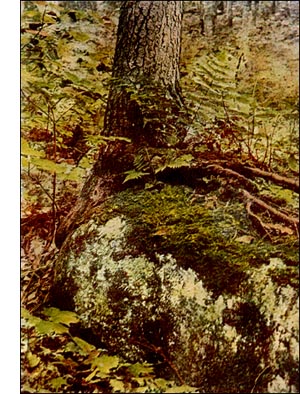Broom Moss
 The Broom-moss, Dicranum scoparium, Hedw.
The Broom-moss, Dicranum scoparium, Hedw.Habit and habitat.-The Broom-moss, Dicranum scoparium, is a conspicuous species. It commonly grows in the woods forming large and symmetrical cushions on the ground, although it may extend in large patches over decaying stumps and logs or on the ground where there is a rich vegetable mould. The longbeaked spore-cases, tilted on one side, commonly point one way, and the leaves also are all turned to one side pointing in the same direction as the beaks. Children fancy they resemble duck heads and see in them flocks travelling toward the water. Some call them soldiers and sing " The troops of Dicranum are tilting their lances."
Name.-The specific name scoparium, the Latin for "broom," is suggested by the resemblance of the plants to small counterbrooms.
Plant (gametophyte).-Large ; stems 2 to 5 inches high in loose yellow, rarely green, tufts, covered with rootlets to the newest growth, forking once or twice.
Leaves.-Glossy, turned to one side, or scythe-shaped, rarely erect, crowded at the tops of the stems ; apex awl-shaped ; base lance-shaped ; vein compressed, with four-toothed ridges on the back toward the apex ; margin sharply serrate and wavy toward the apex ; cells perforated, elongated in the upper part, narrow and worm-like toward the base, large, four-sided and orangecoloured at the angles.
Leaves at the base of the pedicel (perichaetial leaves).-Sheathing at the base.
Habit of flowering.-Male and female flowers on different plants (dioicous).
Veil (calyptra).-Thin, smooth, beaked and split up one side.
Spore-case.--Long, with summit somewhat inclined, rarely erect, cylindrical, somewhat incurved, arched and grooved when dry.
Pedicel (seta).-Solitary, golden-yellow.
Lid (operculum).-Conical at the base, gradually narrowed into a strong beak, reddish, and as long as the spore-case.
Teeth (peristome).-Sixteen, dark-red, cleft to the middle.
Annulus.-None.
Spores.-Mature in summer.
Distribution.-North America, Europe, Asia.